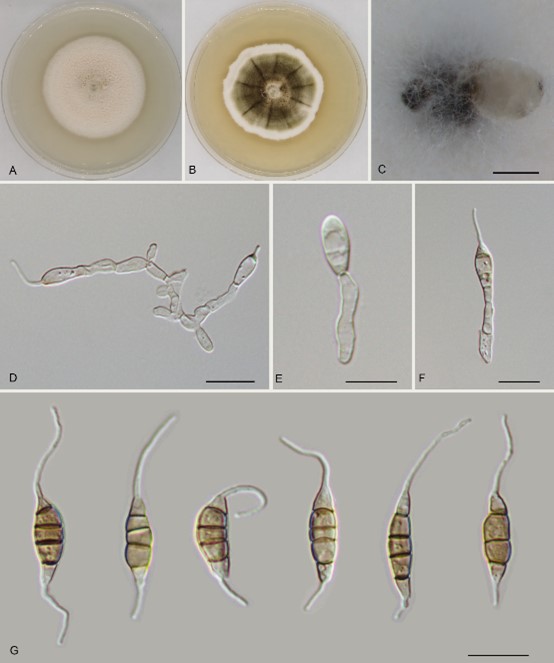Monochaetia lithocarpi N. Jiang, in Jiang, Voglmayr, Xue, Piao & Lia, Microbiology Spectrum: 10.1128/spectrum.00042-23, 4 (2023)
Index Fungorum number: IF 841305; MycoBank number: MB 841305; Facesoffungi number: FoF 11686
Etymology – named after the host genus, Lithocarpus.
Diagnosis – distinct from the phylogenetically related species of M. hanzhongensis by host association.
Pathogenic to host leaves. Asexual state: Conidiomata in culture sporodochial, solitary, erumpent, pulvinate, dark brown, 250–600 μm diam., exuding dark brown conidial masses. Conidiophores septate and branched, hyaline or pale brown, thin-walled. Conidiogenous cells hyaline or pale brown, smooth, cylindrical to subcylindrical, annelidic, 4.5–17 × 2–4 μm, mean ± SD = 10.3 ± 3.4 × 3 ± 0.6 μm. Conidia fusoid, straight or slightly curved, mostly 4-septate, occasionally 3-septate, wall smooth or undulate, not constricted at the septa, but commonly collapsed at septa, (15–)17–22(–24.5) × (4.5–)5–6.5(–7) μm, mean ± SD = 19.4 ± 2.6 × 5.8 ± 1.6 μm (n = 50), L/W = 2.6–4.6; basal cell obconic with a truncate base, thin-walled, hyaline or pale brown, (2.5–)3–4.5(–5) μm; median cells 3 (rarely 2), trapezoid or subcylindrical, brown, thick-walled, the first median cell from base 4–5 μm long, the second cell (2.5–)3–4.5(–5) μm long, the third cell 3–4 μm long, together (10–)10.5–12.5(–13) μm long; apical cell conic with an acute apex, thin-walled, hyaline or pale brown, 3–4 μm long; basal appendage single, unbranched, tubular, centric, straight or bent, 4–13(–17) μm long, mean ± SD = 8.5 ± 3.3 μm; apical appendage single, unbranched, tubular, centric, variously bent, (13–)14.5–21.5(–23.5) μm long, mean ± SD = 17.8 ± 3.5 μm. Sexual morph unknown.
Culture characteristics – colonies on MEA flat, spreading, with radially folded surface and undulate edge, olivaceous gray, reaching 35 mm in diameter after 10 days at 25°C, forming black conidiomata with black conidial masses; colonies on PDA flat, with moderate aerial mycelium and entire edge, white to pale luteous, reaching 40 mm in diameter after 10 days at 25°C, forming black conidiomata with black conidial masses.
Material examined – China, Guangdong Province, Qingyuan City, Yangshan County, Guangdong Nanling Nature Reserve, on diseased leaves of Lithocarpus glaber (Fagaceae), 4 December 2019, Shang Sun (holotype CAF 800017 = JNH0013; ex-holotype culture CFCC 54402); ibid., cultures CFCC 54379 and CFCC 54500.
Distribution – China
Sequence data – ITS: OK339748 (ITS1/ITS4); LSU: OK339777 (LROR/LR5); tef1: OK358476 (EF1-728F/EF2); tub2: OK358485 (Bt2a/Bt2b)
Notes – Three isolates from leaf spots of Lithocarpus glaber clustered into a distinct and well-supported clade in the phylogram, which is described here as the new species Monochaetia lithocarpi (Fig. 1). Monochaetia lithocarpi is phylogenetically close to M. dimorphospora, M. hanzhongensis, M. kansensis, M. quercus, and M. shaanxiensis (Fig. 1). Morphologically, M. lithocarpi has wider conidia than M. dimorphospora (4.5 to 7 μm versus 4 to 4.5 μm in M. dimorphospora) (18) and differs from M. quercus in the length of three median cells of conidia (10 to 13 μm versus 15 to 20 μm in M. quercus). M. lithocarpi shares similar conidial size with M. hanzhongensis, M. kansensis, and M. shaanxiensis (17.5 to 21 by 5 to 6.5 μm in M. hanzhongensis versus 18 to 26 by 6 to 8 μm in M. kansensis versus 15 to 24.5 by 4.5 to 7 μm in M. lithocarpi versus 19 to 22 by 6.5 to 8.5 μm in M. shaanxiensis). However, M. lithocarpi can be distinguished by sequence data (nucleotide differences from M. hanzhongensis in ITS: 10/492 nucleotides [2.1%] and a 32-bp gap; tef1: 68/474 nucleotides [14.35%], 7-bp insertions, and 6-bp gaps; tub2: 39/417 nucleotides [9.35%] and 4-bp gaps; from M. kansensis in ITS: 5/483 nucleotides [1.04%], 1 insertion, and 34-bp gaps; tub2: 36 or 37/412 nucleotides [8.74 to 8.98%] and 5-bp gaps; from M. shaanxiensis in ITS: 12/492 nucleotides [2.44%], 1-bp insertion, and 33-bp gaps; tef1: 77/454 nucleotides [16.96%], 10 insertions, and 5 gaps; tub2: 38/417 nucleotides [9.11%] and 4-bp gaps).

Fig. 3. Morphology of Monochaetia lithocarpi (CFCC 54402). A. Colony on PDA after 10 d at 25 °C; B. Colony on MEA after 10 d at 25 °C; C. Conidioma formed on PDA; D–F. conidiogenous cells giving rise to conidia; G. conidia. — Scale bars: C = 300 μm; D–G = 10 μm.
